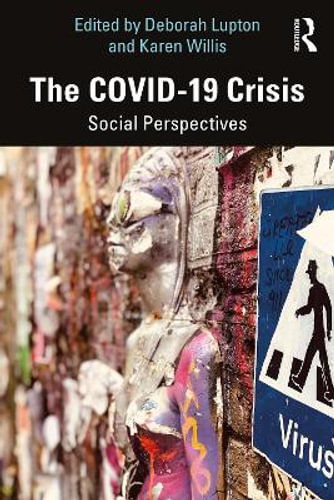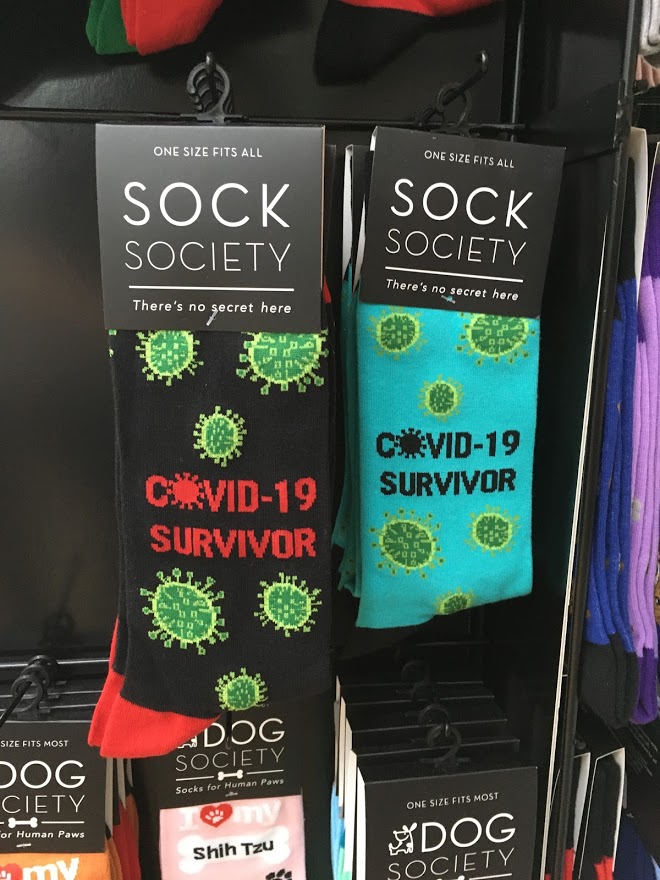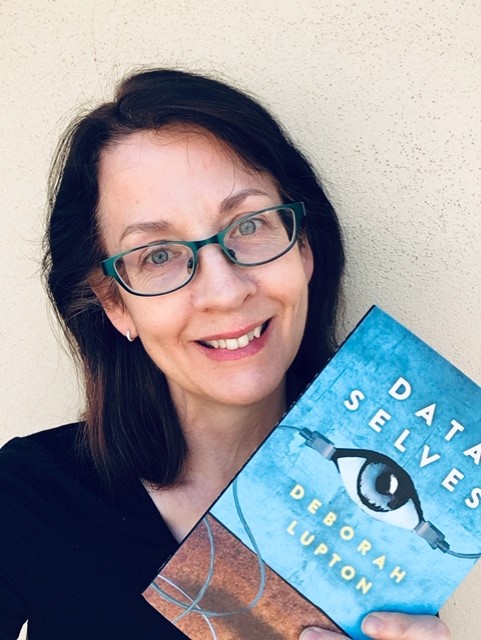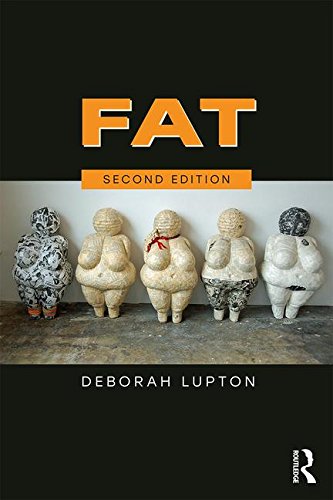This edited collection (with co-editor Karen Willis) is now published (see details on the Routledge website and on Amazon). The chapter abstracts are below. For a companion volume, see my co-authored book The Face Mask in COVID Times: A Sociomaterial Analysis, also now out.
Part 1: Introduction
1. COVID society: introduction to the book
Deborah Lupton and Karen Willis
In this introductory chapter, we make an argument for why contemporary social worlds can be now characterised as ‘COVID society’. We outline the emergence of the COVID-19 crisis and its global effects. The chapter offers an account of the macro- and micro-political dimensions of the COVID crisis and draws out and discusses the key themes emerging across the book’s chapters. We discuss the major findings and perspectives offered by the contributors and how they are employed to analyse the impacts and experiential dimensions of the crisis from a social perspective.
2. Contextualising COVID-19: sociocultural perspectives on contagion
Deborah Lupton
To fully understand the sociocultural implications of the COVID-19 crisis, it is important to be aware of the substantial body of research in sociology, anthropology, history, cultural geography and media studies on previous major infectious disease outbreaks. This chapter ‘sets the scene’ by providing this context with an overview of the relevant literature, with reference to emerging and new infectious diseases over the past century as Spanish influenza, HIV/AIDS, SARS, MERS, Ebola virus and Zika virus. The perspectives offered by social histories, political economy perspectives, social constructionism, Foucauldian theory, risk theory, postcolonial and sociomaterial approaches are explained and examples of research using these approaches are provided.
Part II: Space, the Body and Mobilities
3. Moving target, moving parts: the multiple mobilities of the COVID-19 pandemic
Nicola Burns, Luca Follis, Karolina Follis and Janine Morley
This chapter considers the contributions of the mobilities paradigm to the sociological understanding the COVID-19 pandemic. Mobilities scholarship offers a multi-scalar framework that spans from movement at the molecular level to the movement of bodies and the local, national and supranational travel of humans and non-humans. Its core insight has been the recognition that mobilities are socially patterned, hierarchical and co-exist with immobilities, thereby generating and reproducing inequalities. The chapter focuses on the United Kingdom government response to the coronavirus pandemic, emphasising the multi-scalar effects of state intervention and the implications for different groups in society, which remain largely unaccounted for. We ask: who (and what) moves and does not move in this crisis? We work through the local, meso and macro level to show how the public health imperative to immobilise the disease vector (the body) disrupts ordinary patterns of mobility that have become central to globalised economies. The chapter argues that viewing the COVID-19 pandemic through the prism of mobilities illuminates not just the long-term effects of this crisis on national health systems but also highlights the vulnerability of static and bounded health systems in a world where everything else is in movement.
4. Physical activity and bodily boundaries in times of pandemic
Holly Thorpe, Julie Brice and Marianne Clark
With millions of people around the world spending weeks and months in quarantine, new questions emerged during the COVID-19 pandemic about the opportunities, benefits, and risks of physical activity. Health organizations, governments and the media alike advocated the importance of physical activity for health and wellbeing. While exercise was being encouraged, options for engagement were increasingly constrained. With gyms, fitness studios, recreational centres, and parks and outdoor facilities closed, many created new fitness rhythms and routines. In this chapter we draw upon feminist new materialist theory, and particularly the work of Karen Barad, to critically explore new questions about the risks of physically active bodies and the ‘trails’ of contagion that they may disperse in and through the ebbs and flows of the natural (i.e., air, wind) and built (i.e., gym and fitness studios) environment. Drawing upon Barad’s conceptualization of bodily boundaries, we explore new ethical considerations and concerns of aerosol particles (i.e., breath) and bodily secretions (i.e., sweat). In so doing, we diffractively read media releases, scientific reports, and public commentaries through our own embodied experiences of physical activity. Ultimately this chapter offers a critical and creative commentary on the new noticings of bodily boundaries in times of pandemic where the body—any and every body—was a site of possible contagion.
5. City flows during pandemics: zooming in on windows
Olimpia Mosteanu
In this chapter, I reflect on a series of photographs of windows taken in different cities around the world before and during the COVID-19 pandemic. I use these photographs to prompt an analysis of urban flows at a time when our cities have come to a halt. Windows are caught up in a series of dichotomies that posit what is inside against the outside, the intimate against the public, home against street, stability against unpredictability, among others. The chapter explores some of the ways in which windows not only mediate our interactions with the world around but also actively participate in our everyday lives, especially at the current moment. Given the restrictions brought about by the COVID-19 pandemic, windows have taken on an even more important role in supporting dwellers’ quality of life and wellbeing. Working with and against the digital archive I have compiled, the chapter considers how these photographs gesture towards the layered experiences of space and place, as well as the presence and absence of affect and memory. I conclude by discussing how this type of photographic inquiry benefits qualitative research focused on the lived experience of place at a time when in-person methods are no longer an option.
6. The politics of touch-based help for visually impaired persons during the coronavirus pandemic: an autoethnographic account
Heidi Lourens
In the context of disability, the provision of help carries within it the potential for troublesome psychological and relational dimensions. Through an evocative autoethnography, I, as a blind person, aim to argue that help may become even more complicated for visually impaired persons during the Coronavirus pandemic. Since visually impaired persons often rely on help in the form of physical touch (for example when a sighted person guides them), help currently contains more than psychological dimensions – it also carries within it the very real potential for contracting a potential life-threatening illness. This vulnerable position, I will demonstrate, comes with its own set of psychological ramifications such as the fear of often much-needed or unsolicited touch. I will argue that what makes these feelings of vulnerability and anxiety even more acute, is the limits to freedom of choice for both help-receiver and help-recipient. I conclude that, during this health crisis, it is important to apply the approach of the relational ethics of care. Only through mutual communication, authentic communication and active engagement will disabled and nondisabled persons be able to recognise the unique context and needs of one another.
Part III: Intimacies, Socialities and Temporalities
7. #DatingWhileDistancing: dating apps as digital health technologies during the COVID-19 pandemic
David Myles, Stefanie Duguay and Christopher Dietzel
The physical distancing measures implemented globally by public health authorities have challenged the operating models of dating apps, which typically rely on physical proximity to foster intimate relationships. This chapter critically examines the steps taken by 16 dating apps in response to COVID-19 through an analysis of in-app messages, new features, social media posts, and press releases. Our findings suggest that dating apps assume the role of unconventional corporate digital health technologies. They do so first through interventions in user behaviour, circulating messages about maintaining physical distance while mobilising health resources to track and discourage virus transmission. Secondly, they give meaning to the use of dating apps during a time of physical distancing by encouraging users to adopt online “virtual” dating approaches. This is accomplished by replacing negative perceptions of online dating with notions of virtual dating as romantic or sexy while also introducing features and norms to define appropriate virtual dating behaviour. Overall, our analysis illustrates how corporate actors participate in online health promotion during times of crisis and, specifically, how the matchmaking industry can affect sexual and public health by reshaping contemporary dating cultures.
8. ‘Unhome’ sweet home: the construction of new normalities in Italy during COVID-19
Veronica Moretti and Antonio Maturo
Everyday life provides that reservoir of meanings which allows us to make sense of reality. It is the ‘taken-for-granted’ dimension of our existence. With this in mind, in this chapter we investigate the ‘new normalities’ of life in lockdown. We conducted 20 in-depth interviews with a population of childless, highly educated young adults living in Northern Italy. Interviewees report mixed feelings and experiences associated with being locked in their homes: cosiness alongside restriction; the freedom to call friends combined with forced physical isolation; the need to do work in places usually devoted to relaxing. Being forced to stay at home is also a cognitively ambiguous situation, in which people feel themselves to be ‘in-waiting’. In practical terms, the interviewees coped with this uncertainty by creating and adhering to rigid routines and new habits. We analyse the interviewees’ ‘definition of their situation’ in terms of the Freudian concept of the Unhemlich (the uncanny, but also the ‘unhomely’). The uncanny refers to the psychological experience of something as strangely familiar. It describes situations where something familiar appears in an unsettling context. Our hope is that this analysis will inform future research on the effects of the lockdown on mental health.
9. Queer and crip temporalities during COVID-19: sexual practices, risk and responsibility
Ryan Thorneycroft and Lucy Nicholas
This chapter interrogates sexual practices occurring during COVID-19 to imagine alternative (crip and queer) futures. Recognising that many people continue to engage in (casual) sex, we consider what the politics of responsibility are during this pandemic. We suggest that queer sex sits at the intersections of crip/queer practice, and we move to contextualise our current moment through the lens of crip/queer times. Understanding our moment through crip/queer times provides the opportunity to open up new sexual cultures and to diversify the range of practices and pleasures to all people. In the place of queer casual sex, we introduce forms of (crip/queer) isolation sex as an efficacious and ethical alternative, and in so doing, work to identify new forms of cultures and possibilities available during and after the COVID pandemic. To engage in ethical forms of queer isolation sex at this historical juncture is to protect crip and older bodies from COVID, and this means the actors are engaging in efficacious crip/queer sexual practices. Broadening rather than narrowing what we understand to be sexual practices opens up new forms of cultures and possibilities available during and after COVID. In turn this moment allows for an imagining of broader, alternative, and responsible socialites informed by crip and queer positionalities that do not collapse back into an individualistic normativity once the crisis is over.
10. Isol-AID, Art and Wellbeing: Posthuman Community Amidst COVID-19
Marissa Willcox, Anna Hickey-Moody and Anne Harris
In the isolating times of COVID-19, digital live streaming has been a key means through which artists connect with their audiences/community and audience members access live art and music. With performances mediated through digital live stream, artists and audience members alike are experimenting with strategies for connection, and indeed, for survival. This reconfiguration of sociality, of the liveness of community, threatens to endure beyond the pandemic. The Instagram Live music festival ‘Isol-AID’, which we examine as a case study in this chapter, prompts a discussion around arts accessibility as a measure of public health and wellbeing. Building on literature about social prescribing, we suggest that Instagram Live engages therapeutic forms of arts practice, and as such, could be offered as a new digital health resource. Using a critical posthumanist perspective, we think-through Instagram Live and streamed performance as posthuman assemblages to highlight the importance of non-human actants (such as phones, wifi, colours, sounds) in the production of the feeling of community, which is a social determinant of health. These creative methods of expression and connection encourage discussion around the importance of the arts in community health and wellbeing, a conversation that could not be more relevant than in the socially isolated world that is, this global pandemic.
Part IV: Healthcare Practices and Systems
11. Strange times in Ireland: death and the meaning of loss under COVID-19
Jo Murphy-Lawless
David Harvey writes of ‘time-space compression’ to describe the globalised world of untrammelled flows of goods and services. Contemporary Ireland has relied on these capital flows in the shape of massive foreign direct investment and has in turn been reshaped by contemporary modes of global consumer capitalism. Large-scale emigration characterising Irish society since the mid-nineteenth century has been matched in recent decades by a second kind of international travel whereby Irish people savour life as global consumers. COVID-19, a potent disrupter, is also a beneficiary of our globalised economy. It swiftly rendered everyday life unrecognisable. Among the profoundly stressful consequences of COVID-19 for Ireland is how we were forced to do death differently. COVID-19 has made painfully visible the social and economic contradictions of contemporary Ireland and may yet spur us to reconsider how we participate in the global game.
12. Between an ethics of care and scientific uncertainty: dilemmas of general practitioners in Marseille
Romain Lutaud, Jeremy Ward, Gaëtan Gentile and Pierre Verger
While COVID-19 continues to progress worldwide, the French situation is particularly affected by a lack of masks, tests and, as everywhere else, by the lack of clinically validated therapeutic options. The French government has made the choice of confinement and remote monitoring of patients, with recourse to the healthcare system only when signs of worsening appear (hospitalisation). But in Marseille, a hospital-research centre (IHU, led by Pr. Raoult) decided to apply the doctrine of ‘test and treat’ using chloroquine. This chapter explores the effects of this decision on local doctors’ practices relative to covid-19. We will show the dilemmas faced by doctors: how they navigate the controversy over chloroquine as well as negotiate with their patients’ demand for testing and treatment with chloroquine. This chapter constitutes a first attempt at bringing together the results of a wider research project involving analysis several surveys and interviews conducted among GPs in Marseille and 1200 GPs in France, an analysis of the coverage of the hydroxychloroquine debate in the French national press and surveys conducted among representative samples of the French population. It will also draw on one of the authors’ experience of being a general practitioner in Marseille.
13. Post-pandemic routes in the context of Latin countries: the impact of COVID-19 in Italy and Spain
Anna Sendra, Jordi Farré , Alessandro Lovari and Linda Lombi
This chapter examines the reasons behind the rapid spread of COVID-19 in Italy and Spain, especially at the beginning of the pandemic. Despite adopting strict measures of lockdown, both countries endured two of the highest infection and mortality rates of COVID in Europe. In this context, in addition to considering political, technological and economic factors, this critical reflection explores how the particularities of the Latin lifestyle may have influenced the management of the crisis in Italy and Spain. Although the public agenda in both countries has focused on discussing the unequal distribution of resources, especially in terms of health reforms and digital competencies, this chapter concludes suggesting that the design of future interventions should also contemplate the effect of sociocultural factors in the perception and evaluation of risks.
14. Risky work: providing healthcare in the age of COVID-19
Karen Willis and Natasha Smallwood
The disruption caused by the COVID-19 crisis has been profound across all dimensions of social life; and has been profoundly evident in the rapid changes to work. Alongside people losing jobs in service and related industries as countries imposed restrictions on movement and activity, workers in many industries have faced change in the way work is undertaken, and in their exposure to risks. Healthcare work is a case example of rapid occupational change with concerns that such changes have negative psychosocial effects on the workforce, as they grapple with rapid organisational change, increased anxiety and stress, and concern for patient care. In this chapter, we describe healthcare workers’ experiences of the psychosocial impact of COVID-19 on their work. We draw on preliminary findings from free text data from a survey of over 9,000 health care workers in Australia to illustrate issues related to workplace disruption, healthcare delivery challenges, and concerns of being simultaneously at risk and risky which necessitate the development of new strategies to manage work, home and family.
Part V: Marginalisation and Discrimination
15. The plight of the parent-citizen? Examples of resisting (self-)responsibilisation and stigmatisation by Dutch Muslim parents and organisations during the COVID-19 crisis
Alex Schenkels, Sakina Loukili and Paul Mutsaers
On 15 March 2020, the Dutch government announced the temporary closure of schools, kindergartens and houses of prayer in response to the COVID-19 outbreak, which de facto further responsibilised parents in areas such as home-schooling and home-working. This decision exposed an ideology of intensive parenting (IP) that has mostly remained hidden and undisputed. At the same time, the outbreak exacerbated racism and stigma, intensifying the (parental) challenges for Muslim families. This chapter explores if the boundaries of this ideology have been reached due to the COVID crisis. The first part focuses on education and ways in which Muslim parents display and (eventually) resist ‘self-responsibilising reflexes’. Part two addresses the stigmatisation of Muslims and the (re)actions by Islam-inspired political organisation NIDA. Our findings suggest that while parenting seemed to hyper intensify during the first months of the pandemic, precisely this process led to parents’ resistance. Muslim organisations strengthened resistance by serving as an ‘extended family’, which took form in spiritual and pedagogical guidance as well as in mitigating the effects of racism against Muslim families. Such mitigation undermines IP’s ideal of the ‘parent-citizen’ who is to solve societal problems in the private sphere.
16. Anti-Asian racism, xenophobia and Asian American health during COVID-19
Aggie J. Yellow Horse
As COVID-19 crisis emerged in the USA, anti-Asian racism and xenophobia rhetoric as well as reports of hate incidents against Asian Americans began to rise. Understanding how such a rapid increase in racist and xenophobic incidences may affect Asian Americans’ physical, mental and social health is important, as racism and xenophobia are fundamental causes of inequalities in health in general and for Asian Americans in particular. Furthermore, this understanding is critical for reducing and eliminating the barriers for Asian Americans seeking medical help during the coronavirus pandemic, which is important not only for Asian Americans’ health, but for the total US population. Thus far, research on the health implications of the social, cultural and political dimensions of the coronavirus pandemic on Asian Americans are limited, due to the conceptual and methodological challenges in studying health and health disparities among Asian Americans. Drawing from histories of structural racism against Asian Americans through exclusionary immigration policies, and post-1965 racial policies that contributed to the emergence of Asian American stereotypes as the Model Minority and perpetual foreigners, this chapter discusses the sociohistorical contexts in which Asian Americans have been invisible in sociology of health research. It discusses the importance of examining the roles of racism and xenophobia on Asian American’s health in a broader contexts of the parallel pandemics of COVID-19 and racism; and provides suggestions for future research and policy advocacy.
17. Ageism, risk, health and the body in COVID-19 times
Peta S. Cook, Cassie Curryer, Susan Banks, Barbara Barbosa Neves, Maho Omori, Annetta H. Mallon and Jack Lam
The coronavirus pandemic has laid bare societal discourses regarding age differences and stereotypes. Using sociological approaches to risk and drawing on some examples from the Australian online news media, we illustrate how risk management approaches and risk uncertainties in response to the coronavirus, have homogenised younger and older peoples and widely positioned them in a binary generational conflict of ‘risky’ and ‘at risk’. Younger people are frequently framed as healthy, active agents: they are engaging in risky behaviours that endanger their health and that of others. In contrast, older people have been typically cast as passive and at risk: ‘the elderly’ and ‘the vulnerable elderly’. In extreme cases, older people have also been framed as burdensome and worthless. In this chapter, we examine how age was framed or ‘staged’ during COVID-19 to illustrate how ageist language and dichotomous pandemic framings — grounded on blame and shame — add to social divisions and ‘othering’, shape risk management strategies, and cloud public health messaging on risk, viral spread, and physical distancing measures.














 My new book
My new book 
